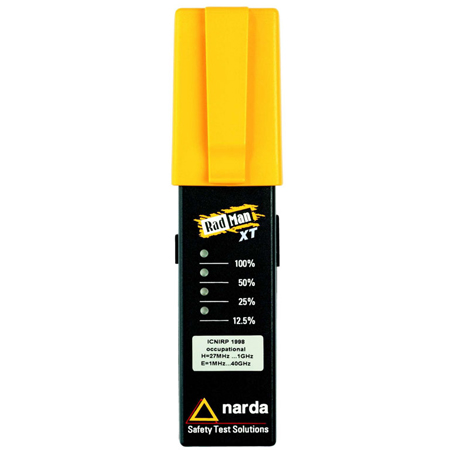» MEASUREMENT AND TEST INSTRUMENTATION » ELECTRIC, MAGNETIC AND ELECTROMAGNETIC FIELD METERS » ESM 30 FAST ICNIRP/LAVORATORI
 |
GET YOUR QUOTE
Main Category:
MEASUREMENT AND TEST INSTRUMENTATION
Secondary Category:
ELECTRIC, MAGNETIC AND ELECTROMAGNETIC FIELD METERS
Specification
Status:
AVAILABLE
Brand:
NARDA PMM
Model Name:
ESM 30 FAST ICNIRP/LAVORATORI
Part number:
2251/56/E
Item Code:
NARDA PMM ESM 30 FAST ICNIRP/LAVORATORI RADMAN XT 2251/56/E DB
Applications:
Measures Work Environments EMF
Environmental measures EMF RF
Description:
Meter personal electromagnetic field with embedded data logger. Frequency range electric component 27 MHz - 40 GHz, the magnetic component 1 MHz - 1 GHz. Simultaneous measurement of electric and magnetic component of electromagnetic field technology, according to the Standard Shaped ICNIRP / workers
General Features:
Audible alarm threshold to overcome useful for noisy environments
Applications: Monitoring of Radar and RF signals in Telecommunications, Broadcast and TV and radio for leakage to RF-MW in the vicinity of coaxial cables, splices, connectors
LED indication 12.5%, 25%, 50% and 100% of the ICNIRP Standard / workers of equivalent power density
Alert threshold: 50% of the ICNIRP Standard / workers of equivalent power density ± 1 dB at a frequency equal
Sensors: light emitting diode technology for electric and magnetic component
Battery power supply (included) with a duration of type 2 X AAA 200 hours when the alarm off
Recommended calibration interval: 36 months
Certificate of Calibration included
Specifications:
Max applicable level (CW): 20 dB above the standard but not more than 10 kV / m or 26.5 A / m
Max applicable level (Peak): 40 dB above the standard for pulse width <10μs
Sensitivity: 6% of the Standard
Frequency Response (flatness): Component Magnetic ± 3 dB ± 3 dB electrical component (up to 3 GHz), +4 / -3 dB (3 GHz to 10 GHz), +6 / -3 dB (10 GHz to 18 GHz), +6 / -10 dB (18 GHz to 40 GHz)
Isotropic response: +4 / -2 dB (27 MHz to 500 MHz)
Immunity to low-frequency electric fields (50/60 Hz): 1 kV / m
Recommended calibration interval: 36 months
Operating Temperature Range: -10 ° C to +55 ° C
Storage Temperature Range: -40 ° C to +70 ° C
Dimensions: 37 x 41 x 163 mm
Weight: 130 g
Headset included
Associated Courses:
RADIO FREQUENCY ELECTROMAGNETIC FIELDS: environmental monitoring techniques
UNCERTAINTIES IN MEASURING EQUIPMENT
MORE INFORMATION